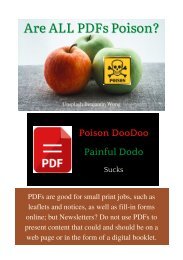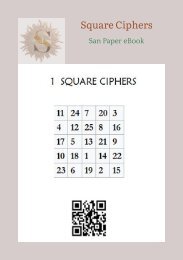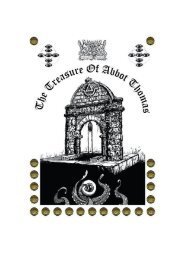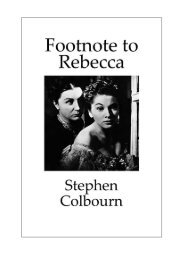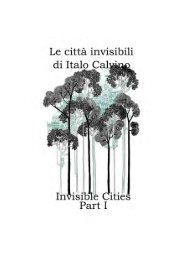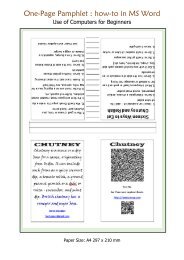chapbook_history_yumpu
a brief history of chapbooks - ancient and modern
a brief history of chapbooks - ancient and modern
You also want an ePaper? Increase the reach of your titles
YUMPU automatically turns print PDFs into web optimized ePapers that Google loves.
Chapbooks<br />
A Brief History<br />
1
San Paper<br />
Being a brief <strong>history</strong> of <strong>chapbook</strong>s,<br />
pamphlets, and related ephemera.<br />
San Paper and Layabout Books<br />
Bangkok and Chiangmai<br />
Created in MS Publisher<br />
Print Version HP Inkjet<br />
https://www.sansap.com<br />
san2paper@gmail.com<br />
Steve Mongkut<br />
2019<br />
2
Chapbooks<br />
What is a <strong>chapbook</strong>?<br />
Contemporary <strong>chapbook</strong>s are often short<br />
collections of poetry or other creative<br />
writing. They may call themselves zines or<br />
simply booklets. Although there is no<br />
standard size, <strong>chapbook</strong>s tend to be in<br />
roughly A6 format (14.8x10.5 cms) and<br />
contain 16 or 24 or 32 pages held together<br />
with a pamphlet stitch or staples. They are<br />
artsy and have graphic designer covers.<br />
Collectible ephemera? They have a long<br />
<strong>history</strong>.<br />
3
San Paper<br />
What was a chapman?<br />
Old English céapmann was the regular term<br />
for a dealer or seller, cognate with the Dutch<br />
koopman which has the same meaning.<br />
Old English céap meant deal, barter,<br />
business. The modern adjective cheap is a<br />
comparatively recent development from the<br />
phrase a good cheap, literally a good deal or<br />
bargain (cf. modern Dutch goedkoop =<br />
cheap). The word also appears in names<br />
such as Cheapside, Eastcheap and<br />
Chepstow - all markets or dealing places.<br />
The name of the Danish capital Copenhagen<br />
has a similar origin, being derived from<br />
Køpmannæhafn, meaning merchants’<br />
harbour or buyers’ haven.<br />
4
Chapbooks<br />
By 1600, the word chapman had come to<br />
mean an itinerant dealer or peddler, but it<br />
remained in use for customer and buyer as<br />
well as merchant in the 17th and 18th<br />
centuries. The slang term for man, chap,<br />
arose from the use of the abbreviated word<br />
to mean a hawker or one with whom to<br />
bargain. "If you want to buy, I'm your chap"<br />
5
San Paper<br />
The name applied to dealers of <strong>chapbook</strong>s,<br />
broadside ballads, and similar items. Their<br />
stock in trade provides an insight into the<br />
methods of political and religious<br />
campaigners during the English Civil War<br />
period, – and here we run into another<br />
question: are pamphlets, together with<br />
tracts, rumplets and bumphlets, the<br />
equivalent of <strong>chapbook</strong>s? No … not exactly.<br />
Chapman is also a common personal name;<br />
it is one of the class of names derived from<br />
trades and is more respectable than peddler<br />
or tinker.<br />
An instance of the use of the term is found<br />
in the opening lines of the poem Tam o'<br />
Shanter by Robert Burns:<br />
Whan chapman billies leave the street<br />
And drouthy neibours neibours meet...<br />
6
Chapbooks<br />
In France, chapmen were colporteurs and<br />
needed a licence to sell bibliothèque bleue.<br />
The German name for a <strong>chapbook</strong> is<br />
perhaps the simplest and clearest –<br />
Volksbuch or People’s Book. How many of<br />
these small books appeared in print?<br />
Who knows? Thousands … tens of<br />
thousands?<br />
7
San Paper<br />
And a further question is—how many<br />
people could read and write in the 17th<br />
century? Chapbooks were often read aloud<br />
and served to encourage and promote<br />
literacy. There was a Register of Printers<br />
who inflamed the populace with tracts and<br />
pamphlets; as a consequence, the number of<br />
Master Printers became subject to state<br />
control and censorship.<br />
8
Chapbooks<br />
Pamphlets<br />
Panflets or pamphlets are older than<br />
<strong>chapbook</strong>s and were originally written by<br />
hand on a single sheet of folded paper. In<br />
the fourteenth century, rag paper became a<br />
fairly common commodity – though not<br />
good cheap. Pamphlets advanced literacy<br />
among the working population and could<br />
be about anything and everything (hence<br />
the pan- prefix). They aimed to please as<br />
amusements or merryments and displayed<br />
one woodcut graphic or ornament on the<br />
front page. They did not have separate<br />
covers. The woodcuts often bore no relation<br />
to the contents of the <strong>chapbook</strong><br />
9
San Paper<br />
Chapbooks arose with the spread of<br />
printing after 1450. They were always<br />
printed and not hand-written. Chapmen<br />
sold them for a penny or less at fairs and in<br />
the streets. They were in black and white,<br />
unless coloured by hand.<br />
These illustrations, from the early 19th<br />
century, are painted in water colours.<br />
10
Chapbooks<br />
What reading matter appeared<br />
in <strong>chapbook</strong>s?<br />
Samuel Pepys, the diarist, collected ballads<br />
in <strong>chapbook</strong> and broadside format. His<br />
classification of popular works covered<br />
most subjects likely to be read by or read<br />
aloud to common folk:<br />
Devotion and Morality; History – true<br />
and fabulous; Tragedy: viz. Murders,<br />
executions, and judgments of God; State<br />
and Times; Love – pleasant; Ditto –<br />
unpleasant; Marriage, Cuckoldry, et cet; Sea<br />
– love, gallantry & actions; Drinking and<br />
good fellowship; Humour, frollicks and<br />
mixt.<br />
https://en.wikipedia.org/wiki/Chapbook<br />
11
San Paper<br />
There was an audience for Blood and<br />
Thunder and the grotesque before the rise<br />
of Penny Dreadfuls in the 19th century.<br />
12
Chapbooks<br />
Penny Plain, Two-pence<br />
Coloured<br />
By the early 19th century, <strong>chapbook</strong>s<br />
appeared in colour—and gave rise to the<br />
saying above. The illustrations were handcoloured,<br />
largely by orphan children.<br />
13
San Paper<br />
Related Publications<br />
The broadside or broadsheet, mentioned<br />
above, was a single larger sheet of paper<br />
which was printed on one side only. This<br />
might be a poster or newspaper, or a ballad<br />
sheet.<br />
The mass production of paper and the<br />
mechanization of printing gave rise to other,<br />
longer penny publications—the most<br />
memorable being the Penny Blood or Penny<br />
Dreadful: Varney the<br />
Vampire. Sweeney Todd.<br />
Springheel Jack etc. These<br />
were fictions which<br />
entered urban legend.<br />
14
Chapbooks<br />
The 19th Century Arts and Crafts<br />
movement attempted a revival of the<br />
<strong>chapbook</strong> as a modern medieval goody, but<br />
it paled against the comic and later the<br />
graphic novel. The most fashionable<br />
contemporary form is the Japanese anime<br />
and manga, as well as the arty zine.<br />
15
San Paper<br />
In 1982, Stephen King sent out <strong>chapbook</strong>s<br />
instead of Christmas cards. The contents<br />
were the first chapter of his latest work.<br />
Stephen King claimed to be the first author<br />
to write a novel on a word processor, as<br />
Mark Twain had claimed to be the first to<br />
use a typewriter for The Adventures of Tom<br />
Sawyer in 1876.<br />
The high quality of home printers allows<br />
anyone to create their own <strong>chapbook</strong> on a<br />
computer. San Paper and Layabout Books<br />
offers advice on making your own book.<br />
Steve Mongkut<br />
san2paper@gmail.com<br />
16









